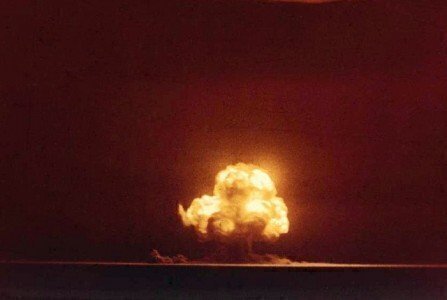On a July morning in New Mexico in July 1945, the modern world changed with the first successful test detonation of a nuclear weapon. The debate continues today about the use of the technology.

On Tuesday, the United States, Iran and five other nations announced a deal to potentially limit Iran’s development of a nuclear weapon. Currently, nine countries are known to have nuclear weapons, according to the Federation of American Scientists. The Iran deal will be heavily debated in Congress over its effectiveness in keeping Iran from becoming the 10th member of the nuclear club. In addition, 31 nations use nuclear reactors as powers sources.
Back in July 1945, the United States was close to verifying an effective atomic bomb that it had started considering in 1939, after a letter from Albert Einstein and Leo Szilard notified President Franklin D. Roosevelt about the destructive potential of nuclear fission research and its potential use by Nazi Germany.
Link: Read The Letter
Alexander Sachs, a presidential confidant, met with President Roosevelt to review the letter and research. "Alex," Roosevelt reportedly said, "what you are after is to see that the Nazis don't blow us up." By late 1941, the American nuclear program was given its code name, the Manhattan Project, and in late 1942, Enrico Fermi conducted the first successful nuclear chain reaction test in Chicago.
In all, the United States spent an estimated $2 billion on a project that employed more than 120,000 people to build a nuclear weapon. The critical field test of a nuclear device was scheduled for July 16, 1945, to coincide with the arrival of President Harry Truman at the Potsdam Conference.
The test bomb was placed on a 100-foot tower near Alamogordo, New Mexico. Government officials and scientists weren’t sure what to expect when the device called Gadget was detonated at 5:30 a.m. The explosion was about four times stronger than anticipated by some scientists at Los Alamos; Robert Oppenheimer later remarked the blast reminded him of a passage from Hindu text, the Bhagavad-Gita: "Now I am become Death, the destroyer of worlds."
Within a month, the United States military had dropped two atomic bombs on Japan, facilitating the end of World War II and the start of the Cold War. Truman had told Soviet leader Joseph Stalin about a new weapon of mass destruction while at Potsdam; the Soviets already knew secretly about the American program and were working on their own atomic research.
The nuclear race between the Americans and Soviets became an immense cause for international concern, and by the mid-1950s, the United Nations sought to work with two nations, and other potential nuclear powers, to reign in nuclear testing.
In August 1963, after eight years of talks during the height of the Cold War, President John F. Kennedy and Soviet leader Nikita Khrushchev agreed to the Limited Nuclear Test Ban Treaty. On September 23, 1963 the agreement was approved by the U.S. Senate, by an 80-19 margin. President Kennedy then ratified the treaty on October 7, 1963.
The Limited Nuclear Test Ban Treaty banned nuclear weapons testing under water, in the atmosphere, or in outer space, but it permitted underground tests if radioactive debris fell within the boundaries of a country conducting the test. (Eventually 125 nations signed on to the treaty.)
A second treaty with broader test limitations, the Comprehensive Nuclear Test Ban Treaty, was approved by the United Nations in September 1996. President Bill Clinton sent the treaty to the U.S. Senate, where it was rejected by a 51 to 48 margin in 1999, well-short of the two-thirds vote demanded by the Constitution.
At that point, most members of the nuclear club had stopped testing nuclear devices. In recent years, only North Korea has publicly acknowledged nuclear weapons tests.







